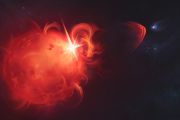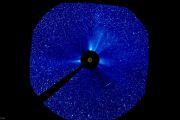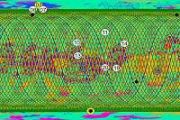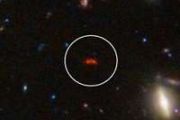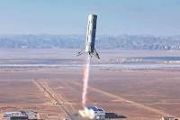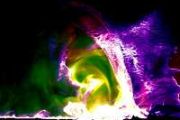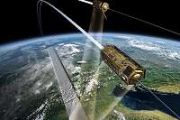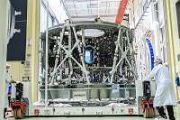
Copernical Team
Sahara space rock 4.5 billion years old upends assumptions about the early solar system

In May 2020, some unusual rocks containing distinctive greenish crystals were found in the Erg Chech sand sea, a dune-filled region of the Sahara Desert in southern Algeria.
On close inspection, the rocks turned out to be from outer space: lumps of rubble billions of years old, left over from the dawn of the solar system.
They were all pieces of a meteorite known as Erg Chech 002, which is the oldest volcanic rock ever found, having melted long ago in the fires of some now-vanished ancient protoplanet.
In new research published in Nature Communications, we analyzed lead and uranium isotopes in Erg Chech 002 and calculated it is some 4.56556 billion years old, give or take 120,000 years. This is one of the most precise ages ever calculated for an object from space—and our results also cast doubt on some common assumptions about the early solar system.
The secret life of aluminum
About 4.567 billion years ago, our solar system formed from a vast cloud of gas and dust.
Wired for space - Muscle stimulation to enhance astronaut health
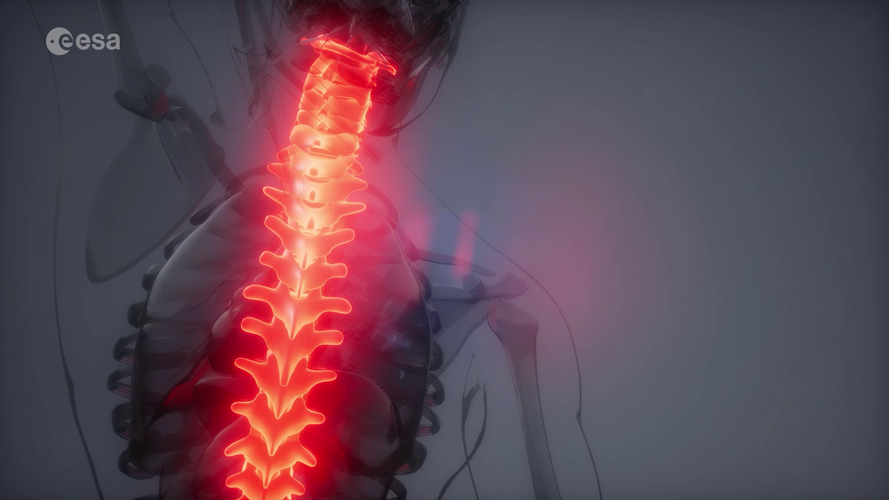 Video:
00:05:10
Video:
00:05:10
Space exploration presents unique health challenges for astronauts due to lack of gravity, isolation, and radiation exposure. ESA's SciSpacE activities aim to comprehend these effects and their implications for human well-being during extended missions.
ESA collaborates with researchers to conduct experiments in microgravity and analogue environments, shedding light on the consequences of space stressors. One critical concern is muscle and bone atrophy. Despite daily exercise routines, astronauts face deterioration. ESA is investigating electrical stimulation as a potential countermeasure, with tests planned on board the International Space Station.
The "Muscle Stimulation" experiment is a centrepiece of this research. By applying
LeoStella and Hera Systems Establish Strategic Alliance
 Focused on revolutionizing satellite manufacturing and diversifying customers' choices for multi-satellite solicitations, smallsat experts LeoStella and Hera Systems have announced a strategic manufacturing alliance. This collaboration will mitigate supply chain risks, increase the reliability of production and delivery schedules, and maintain competitive pricing for small satellite constellatio
Focused on revolutionizing satellite manufacturing and diversifying customers' choices for multi-satellite solicitations, smallsat experts LeoStella and Hera Systems have announced a strategic manufacturing alliance. This collaboration will mitigate supply chain risks, increase the reliability of production and delivery schedules, and maintain competitive pricing for small satellite constellatio Investigation onboard ISS seeks new insights into cooling technology for electronics
 What if microgravity holds the key to preventing the overheating of advanced electronics? That's one idea behind an International Space Station (ISS) National Laboratory-sponsored investigation that recently launched to station on Northrop Grumman's 19th Commercial Resupply Services mission (NG-19). This week, the ISS crew is working on the experiment, which aims to improve the efficiency of hea
What if microgravity holds the key to preventing the overheating of advanced electronics? That's one idea behind an International Space Station (ISS) National Laboratory-sponsored investigation that recently launched to station on Northrop Grumman's 19th Commercial Resupply Services mission (NG-19). This week, the ISS crew is working on the experiment, which aims to improve the efficiency of hea Momentus to provide hosted payload services for FOSSA Systems
 Momentus Inc. (NASDAQ: MNTS) has signed a contract with FOSSA Systems ("FOSSA"), a Spanish company that offers global low-power Internet of Things (IoT) connectivity and in-space services to provide hosted payload services starting in 2024. The contract also includes two options for additional hosted payloads.
The hosted payloads will strategically complement FOSSA's existing IoT satellite
Momentus Inc. (NASDAQ: MNTS) has signed a contract with FOSSA Systems ("FOSSA"), a Spanish company that offers global low-power Internet of Things (IoT) connectivity and in-space services to provide hosted payload services starting in 2024. The contract also includes two options for additional hosted payloads.
The hosted payloads will strategically complement FOSSA's existing IoT satellite Private rocket maker sends remote-sensing satellite into orbit
 Galactic Energy, a private rocket maker in Beijing, carried out on Friday the eighth flight mission of its CERES 1 rocket to deploy a remote-sensing satellite into orbit.
The CERES 1 Y8 rocket blasted off at 12:57 pm at the Jiuquan Satellite Launch Center in northwestern China's Gobi Desert and placed the Jilin 1 Wide-View 02A satellite into its preset orbit, the company said in a news rel
Galactic Energy, a private rocket maker in Beijing, carried out on Friday the eighth flight mission of its CERES 1 rocket to deploy a remote-sensing satellite into orbit.
The CERES 1 Y8 rocket blasted off at 12:57 pm at the Jiuquan Satellite Launch Center in northwestern China's Gobi Desert and placed the Jilin 1 Wide-View 02A satellite into its preset orbit, the company said in a news rel New X-ray Detectors to Provide Unprecedented Vision of the Invisible Universe
 Very detailed information is now available from ultraviolet, optical, and submillimeter observations of the stellar, dust, and cold gas content of galaxies, and yet there is a dearth of understanding about the mechanisms that formed these galaxies. To truly understand how galaxies form, X-ray observations from high energy resolution imaging spectrometers are needed to see the cores of the galaxi
Very detailed information is now available from ultraviolet, optical, and submillimeter observations of the stellar, dust, and cold gas content of galaxies, and yet there is a dearth of understanding about the mechanisms that formed these galaxies. To truly understand how galaxies form, X-ray observations from high energy resolution imaging spectrometers are needed to see the cores of the galaxi Dead stars cast long shadows: WVU astronomer hunts for the glowing ghosts of supernovas
 A West Virginia University astronomer is searching the Milky Way for debris left behind by supernovas, the violent explosions that occur when massive stars die.
After a supernova explosion, material that was part of the star expands outward, forming a shell or "remnant." According to Loren Anderson, professor at the Eberly College of Arts and Sciences, studying supernova remnants is "essen
A West Virginia University astronomer is searching the Milky Way for debris left behind by supernovas, the violent explosions that occur when massive stars die.
After a supernova explosion, material that was part of the star expands outward, forming a shell or "remnant." According to Loren Anderson, professor at the Eberly College of Arts and Sciences, studying supernova remnants is "essen Sols 3932-3933: Touch and Go, Go, Go!
 Earth planning date: Monday, August 28, 2023: Curiosity successfully navigated the numerous resistant, dark boulders (once included in the Gediz Vallis ridge deposit and the focus of our recent investigations), 20 degree slopes and broken up bedrock to cover a distance of ~65 m back towards our planned ascent route up Mount Sharp in the weekend plan.
This is one of our longer recent drives
Earth planning date: Monday, August 28, 2023: Curiosity successfully navigated the numerous resistant, dark boulders (once included in the Gediz Vallis ridge deposit and the focus of our recent investigations), 20 degree slopes and broken up bedrock to cover a distance of ~65 m back towards our planned ascent route up Mount Sharp in the weekend plan.
This is one of our longer recent drives PSI study shows evidence of highly mobile lunar regolith
 Swirls are enigmatic albedo (light reflection) patterns on the lunar surface associated with local magnetic anomalies. The processes involved in their formation have been examined and debated since their discovery. The most popular idea is shielding of the surface from solar wind radiation by the associated magnetic anomaly. This explains the swirling pattern, as shielded material would be brigh
Swirls are enigmatic albedo (light reflection) patterns on the lunar surface associated with local magnetic anomalies. The processes involved in their formation have been examined and debated since their discovery. The most popular idea is shielding of the surface from solar wind radiation by the associated magnetic anomaly. This explains the swirling pattern, as shielded material would be brigh 





